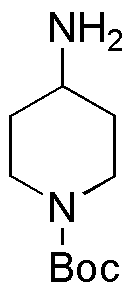1-Boc-4-aminopiperidine is widely utilized in research focused on:
- Pharmaceutical Development: This compound serves as a key intermediate in the synthesis of various pharmaceuticals, particularly in the development of drugs targeting neurological disorders.
- Organic Synthesis: It is commonly used in organic chemistry for the construction of complex molecules, allowing researchers to create compounds with specific functional groups efficiently.
- Biochemical Research: The compound is valuable in studying enzyme interactions and protein functions, aiding in the understanding of biological processes at the molecular level.
- Material Science: Its properties make it suitable for developing new materials, including polymers and coatings, that require specific chemical stability and reactivity.
- Drug Design: Researchers leverage this compound in structure-activity relationship studies, helping to optimize the efficacy and safety profiles of new therapeutic agents.
Informations générales
Propriétés
Sécurité et réglementation
Applications
1-Boc-4-aminopiperidine is widely utilized in research focused on:
- Pharmaceutical Development: This compound serves as a key intermediate in the synthesis of various pharmaceuticals, particularly in the development of drugs targeting neurological disorders.
- Organic Synthesis: It is commonly used in organic chemistry for the construction of complex molecules, allowing researchers to create compounds with specific functional groups efficiently.
- Biochemical Research: The compound is valuable in studying enzyme interactions and protein functions, aiding in the understanding of biological processes at the molecular level.
- Material Science: Its properties make it suitable for developing new materials, including polymers and coatings, that require specific chemical stability and reactivity.
- Drug Design: Researchers leverage this compound in structure-activity relationship studies, helping to optimize the efficacy and safety profiles of new therapeutic agents.
Documents
Fiches de données de sécurité (FDS)
La FDS fournit des informations de sécurité complètes sur la manipulation, le stockage et l’élimination du produit.
Spécifications du produit (PS)
Le PS fournit une description complète des propriétés du produit, notamment sa composition chimique, son état physique, sa pureté et les exigences de stockage. Il détaille également les plages de qualité acceptables et les applications prévues du produit.
Certificats d'analyse (COA)
Recherchez des certificats d'analyse (COA) en saisissant le numéro de lot du produit. Les numéros de lot et de lot se trouvent sur l'étiquette d'un produit, après les mots « Lot » ou « Lot de fabrication ».
Numéro de catalogue
Numéro de lot/série
Certificats d'origine (COO)
Ce certificat d'exploitation confirme le pays dans lequel le produit a été fabriqué, et détaille également les matériaux et composants utilisés et s'il est issu de sources naturelles, synthétiques ou autres sources spécifiques. Ce certificat peut être requis pour les douanes, le commerce et la conformité réglementaire.
Numéro de catalogue
Numéro de lot/série
Fiches de données de sécurité (FDS)
La FDS fournit des informations de sécurité complètes sur la manipulation, le stockage et l’élimination du produit.
DownloadSpécifications du produit (PS)
Le PS fournit une description complète des propriétés du produit, notamment sa composition chimique, son état physique, sa pureté et les exigences de stockage. Il détaille également les plages de qualité acceptables et les applications prévues du produit.
DownloadCertificats d'analyse (COA)
Recherchez des certificats d'analyse (COA) en saisissant le numéro de lot du produit. Les numéros de lot et de lot se trouvent sur l'étiquette d'un produit, après les mots « Lot » ou « Lot de fabrication ».
Numéro de catalogue
Numéro de lot/série
Certificats d'origine (COO)
Ce certificat d'exploitation confirme le pays dans lequel le produit a été fabriqué, et détaille également les matériaux et composants utilisés et s'il est issu de sources naturelles, synthétiques ou autres sources spécifiques. Ce certificat peut être requis pour les douanes, le commerce et la conformité réglementaire.


